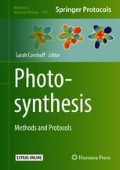Abstract
The unusually high tolerance toward chemical functional groups of the copper(I)-catalyzed Huisgen-Sharpless-Meldal 1,3-dipolar cycloaddition of azides and alkynes protocol (the CuAAC or “click” reaction) associated with its mild conditions and high yields has been explored in the present methodology to successfully prepare water oxidation catalyst iridium oxide nanoparticles decorated with organic dyes. The “click reaction” has proven to be an excellent synthetic tool to overcome the incompatible solubility of the hydrophilic iridium oxide nanoparticles and the hydrophobic dyes. A complex artificial photosynthetic model designed to mimic the photoinduced redox processes occurring in photosystem II is used as a hydrophobic dye to highlight the efficiency and selectiveness of the method.
Access this chapter
Tax calculation will be finalised at checkout
Purchases are for personal use only
References
Blankenship RE et al (2011) Comparing photosynthetic and photovoltaic efficiencies and recognizing the potential for improvement. Science 332:805–809
Hoffert MI et al (2002) Advanced technology paths to global climate stability: energy for a greenhouse planet. Science 298:981–987
Lewis NS, Nocera DG (2006) Powering the planet: chemical challenges in solar energy utilization. Proc Natl Acad Sci U S A 103:15729–15735
Gust D, Moore TA, Moore LA (2011) Realizing artificial photosynthesis. Faraday Discuss 155:9–26
Barber J (2008) Photosynthetic energy conversion: natural and artificial. Chem Soc Rev 38:185–196
Blankenship RE (2002) Molecular mechanisms of photosynthesis. Blackwell Science, Oxford
Gust D, Moore TA, Moore LA (2009) Solar fuels via artificial photosynthesis. Acc Chem Res 42:1890–1898
Megiatto JD Jr et al (2012) Mimicking the electron transfer chain in photosystem II with a molecular triad thermodynamically capable of water oxidation. Proc Natl Acad Sci U S A 109:15578–15583
Megiatto JD Jr et al (2014) A bioinspired redox relay that mimics radical interactions of the Tyr–His pairs of photosystem II. Nat Chem 6:423–428
Zhao Y et al (2012) Improving the efficiency of water splitting in dye-sensitized solar cells by using a biomimetic electron transfer mediator. Proc Natl Acad Sci U S A 109:15612–15616
Sherman BD et al (2014) Evolution of reaction center mimics to systems capable of generating solar fuel. Photosynth Res 120:59–70
Sherman BD et al (2016) A tandem dye-sensitized photoelectrochemical cell for light driven hydrogen production. Energy Environ Sci 9:1812–1817
O’Regan B, Grätzel M (1991) A low-cost, high-efficiency solar cell based on dye-sensitized colloidal TiO2 films. Nature 353:737–740
Grätzel M (2001) Photoelectrochemical cells. Nature 414:338–344
Youngblood WJ et al (2009) Photoassisted overall water splitting in a visible light absorbing dye-sensitized photoelectrochemical cell. J Am Chem Soc 131:926–927
Hara M, Waraksa CC, Lean JT, Lewis BA, Mallouk TE (2000) Photocatalytic water oxidation in a buffered tris(2,2′-bipyridyl)ruthenium complex-colloidal IrO2 system. J Phys Chem A 104:5275–5280
Hoertz PG, Kim YI, Youngblood WJ, Mallouk TE (2007) Bidentate dicarboxylate capping groups and photosensitizers control the size of IrO2 nanoparticle catalysts for water oxidation. J Phys Chem B 111:6845–6856
Harriman A, Thomas JM, Millward GR (1987) Catalytic and structural-properties of iridium-iridium dioxide colloids. New J Chem 11:757–762
Huisgen R (1968) Cycloadditions – definition, classification, and characterization. Angew Chem Int Ed Engl 7:321–328
Kolb HC, Finn MG, Sharpless KB (2001) Click chemistry: diverse chemical function from a few good reactions. Angew Chem Int Ed 40:2004–2021
Tornøe CW, Christensen C, Meldal M (2002) Peptidotriazoles on solid phase: [1,2,3]-triazoles by regiospecific copper(I)-catalyzed 1,3-dipolar cycloadditions of terminal alkynes to azides. J Org Chem 67:3057–3064
Megiatto JD Jr et al (2012) Intramolecular hydrogen bonding as a synthetic tool to induce chemical selectivity in acid catalyzed porphyrin synthesis. Chem Comm 48:4558–4560
Wagner RW, Ciringh Y, Clausen C, Lindsey JS (1999) Investigation and refinement of palladium-coupling conditions for the synthesis of ciarylethyne-linked multiporphyrin arrays. Chem Mater 11:2974–2983
Lewis WG, Magallon FG, Fokin VV, Finn MG (2004) Discovery and characterization of catalysts for azide−alkyne cycloaddition by fluorescence quenching. J Am Chem Soc 126:9152–9153
Megiatto JD Jr, Schuster DI (2008) General method for synthesis of functionalized macrocycles and catenanes utilizing “click” chemistry. J Am Chem Soc 130:12872–12873
Megiatto JD Jr et al (2010) [2]catenanes decorated with porphyrin and [60]fullerene groups: design, convergent synthesis, and photoinduced processes. J Am Chem Soc 132:3847–3861
Kimer SV et al (2015) Synthesis and photophysical properties of new catenated electron donor-acceptor materials with magnesium and free base porphyrins as donors and C60 as the acceptor. Nanoscale 7:1145–1160
Megiatto JD Jr et al (2011) Optimizing reaction conditions for synthesis of electron donor-[60]fullerene interlocked multiring systems. J Chem Mat 21:1544–1550
Acknowledgments
This work was supported by FAPESP (The State of São Paulo Research Foundation, Brazil) under Award Numbers 2013/22160-0 and 2015/23761-2.
Author information
Authors and Affiliations
Corresponding author
Editor information
Editors and Affiliations
Rights and permissions
Copyright information
© 2018 Springer Science+Business Media, LLC, part of Springer Nature
About this protocol
Cite this protocol
Megiatto, J.D., Ornelas, C. (2018). “Click” Methodology for the Functionalization of Water Oxidation Catalyst Iridium Oxide Nanoparticles with Hydrophobic Dyes for Artificial Photosynthetic Constructs. In: Covshoff, S. (eds) Photosynthesis. Methods in Molecular Biology, vol 1770. Humana Press, New York, NY. https://doi.org/10.1007/978-1-4939-7786-4_19
Download citation
DOI: https://doi.org/10.1007/978-1-4939-7786-4_19
Published:
Publisher Name: Humana Press, New York, NY
Print ISBN: 978-1-4939-7785-7
Online ISBN: 978-1-4939-7786-4
eBook Packages: Springer Protocols

